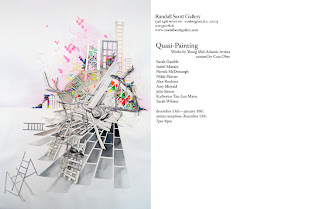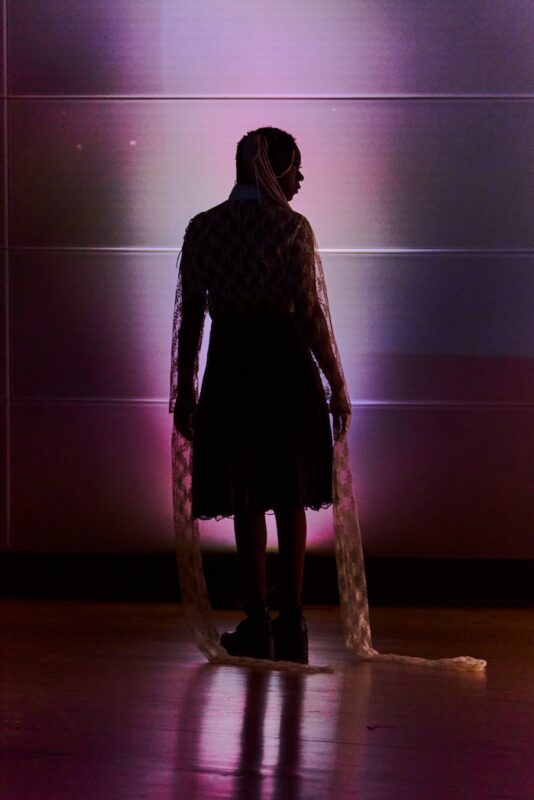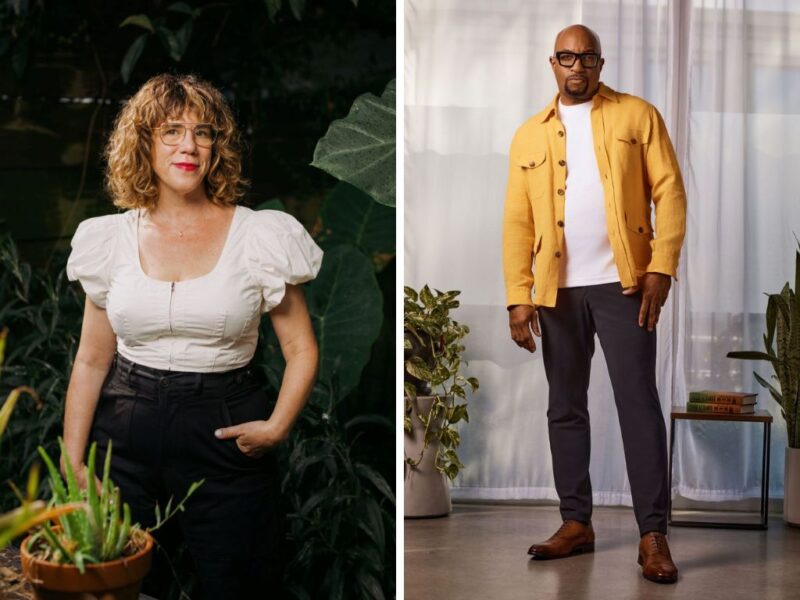Quasi-Painting: Works by Young Mid-Atlantic Artists
Curated by Cara Ober
Artists Include: Sarah Gamble, Isabel Manalo, Patrick McDonough, Nikki Painter, Alex Roulette, Amy Sherald, Julie Simon, Katherine Tzu-Lan Mann and Sarah Wilmer (painting above by Alex Roulette)
Dec 13th-Jan 10th
Opening reception Dec 13th 7-9pm (work below by Nikki Painter)
Quasi-Painting: Works by Young, Mid-Atlantic Artists
Curatorial Statement by Cara Ober
Painting has been dead for over a century, yet artists keep making them anyway. Despite the invention of photography, video, and digital art, painting still remains a vital method of present-day artistic expression. Even in a Post-Greenburgian era, full of dire predictions from critics, painting continues to be an important component of the vocabulary of contemporary art.
The main appeal of painting lies in its inherent physical qualities: both liquid and solid, it forces its practitioner to think spatially and abstractly, rather than in a linear way. This immediate access to color, light, atmosphere, and form is as important as the product of such thinking. Painters tend to think globally, to see the big picture rather than in parts, and to rely on experience and intuition, rather than logic. As shape and space merge in the mind of a painter, physical and emotional sensations combine into a one-of-a-kind product, which visually references the artist’s hand, brain, and heart.
Even in photographs, prints, drawing, and sculpture, a painterly sensibility often persists in modern modes of thinking. Despite new tools and technologies, which promise to render physical painting obsolete, the liquid, nonverbal thought process seems to grow. Painterly thinking is evident in cinematography, in theatre, in contemporary art, in bio-chemistry, literature, and education, as well as in other multidisciplinary fields. In Quasi-Painting, I have chosen to exhibit nine emerging artists together, not necessarily because they make artwork with paint, but because they share a painterly sensibility, expressed nine different ways.
Isabel Manalo is a DC-based painter who drips gooey, candy-colored paint onto buttery white surfaces. These chunky value-shapes transform at a distance into loose and undulating landscapes, but actually reference sinister crime scenes.
MICA Senior Alex Roulette’s painted environments resonate in brilliant, dark tones, creating ambiguous and theatrical settings for his human subjects, with a sense of impending action. Alex’s control over lighting and color reinforces the drama of each moment he depicts in a tight, photo-realist style, while a rich, painterly surface negates the perfection in each scene.
American University MFA candidate Nikki Painter creates formal abstractions on paper and canvas, expressing conflict and resolution at the same time. In Painter’s search for an uneasy balance, she contrasts white voids with prismatic color arrangements, and architecture with graphic pattern.
Silver Spring-based Julie Simon literally ‘paints with light’ in her abstract color photos, which resemble emotive Abstract Expressionistic paintings. Intensely brilliant strokes of colored light blurs and coalesces into shapes, while contrasts in value create depth and layers. Simon captures transparent, colored light, without any recognizable subject matter, into formal abstractions and demonstrate the overlap in media and thinking involved in both painting and photography.
George Washington University MFA candidate Patrick McDonough collages color, text, and found objects into sculptural assemblages, which function both two and three dimensionally. These clunky and bold arrangements are uncertain whether to function as paintings or sculptures and challenge the boundaries of each process. With a sense of humor and a playful hand, McDonough transforms ordinary materials into new images and objects which reinforce pop culture and also question it.
Brooklyn-based Sarah Wilmer makes painterly photographs often resemble Renaissance paintings, with golden light and formal compositions. The influence of painting, and painterly thinking, has enabled Wilmer to reach across media boundaries to create photographs that not only capture reality, but an uber-reality that is more rich and more dense than an ordinary snapshot.
MICA MFA candidate Katherine Mann combines abstract and figurative elements into swirling combinations of Eastern and Western influences. These paintings are menageries of different types of thinking and imagery, in which the parts remain distinct. Mann harmoniously combines elements along formal and conceptual criteria to express a contemporary sensibility that is both sensitive and lyrical.
Philadelphia painter Sarah Gamble creates quirky, pseudo-scientific works, which combine nature and culture in loosely brushed surfaces. In both her canvasses and works on paper, her use of color is deceptively sophisticated. Artificial, toxic colors compete with rainbow hues in gleefully hideous combinations. Under Gamble’s hand, raw emotion comes through the colors and marks with a life of its own.
Many painters have managed to harness the power of the human gaze, and Baltimore-based Amy Sherald’s sensitive, color saturated portraits continue this tradition. In bright and somber color, Sherald explores emotive modes of collaboration between artist and subject. Large in scale, but quiet in tone, Sherald’s portraits do not simply capture the appearance of her sitters, they manage to reach through the surface to a more direct, physical essence.
These nine artists do not share any one style, aesthetic, subject matter, or theme. However, when viewed together, their works provide a panoramic view of the potential applications of non-verbal, spatial thinking, a model that has evolved and adapted since civilization began. In Quasi-Painting, these nine artists serve as unique points and counterpoints to the modicum of contemporary painting.





